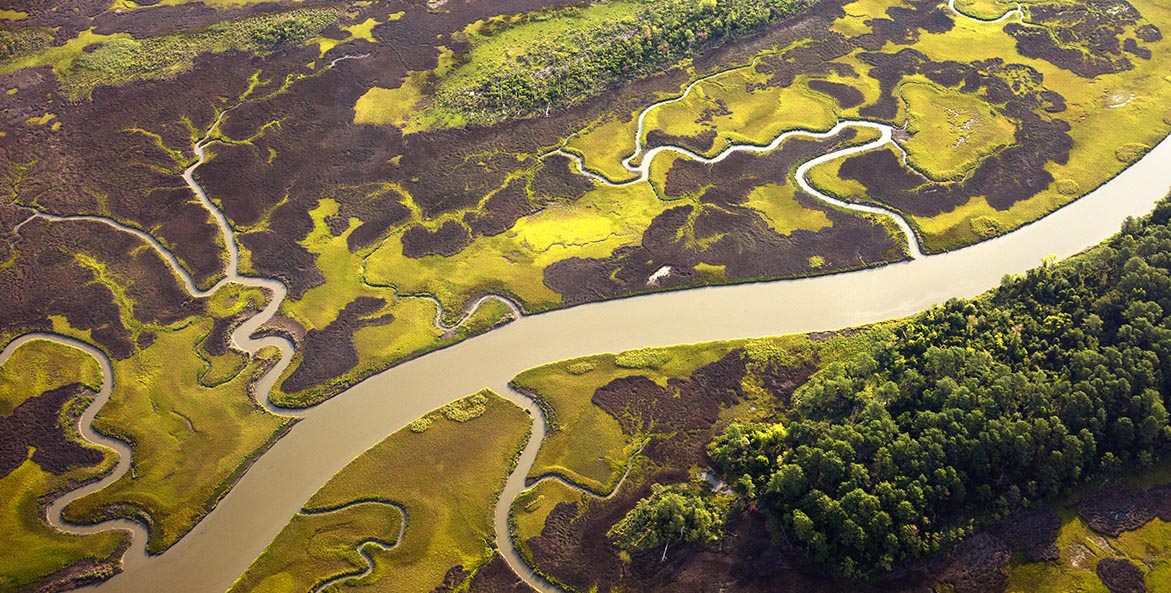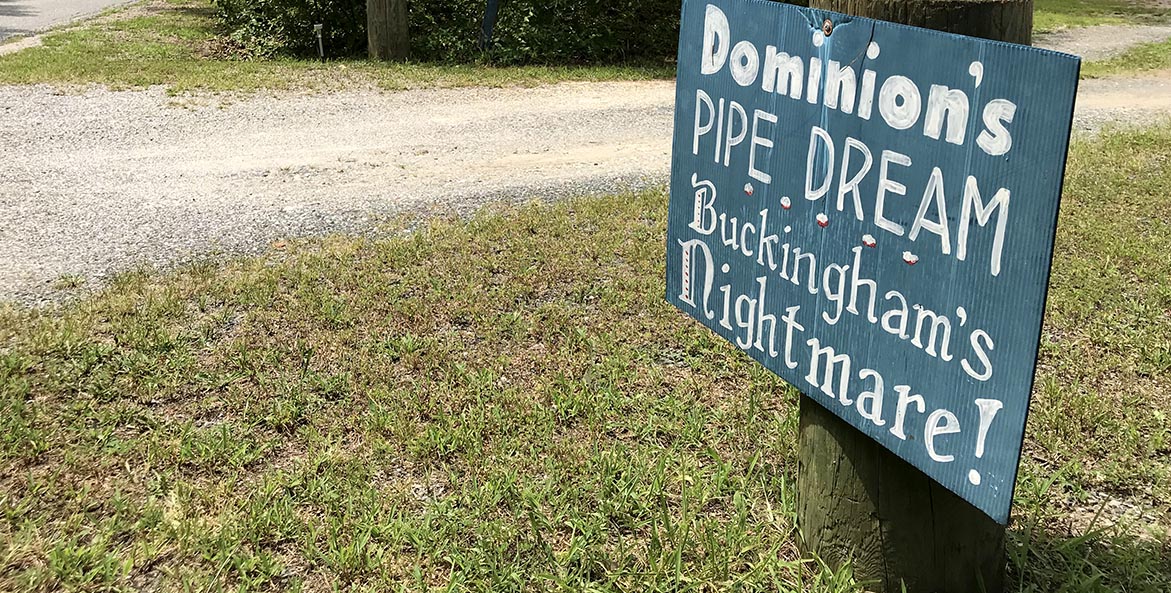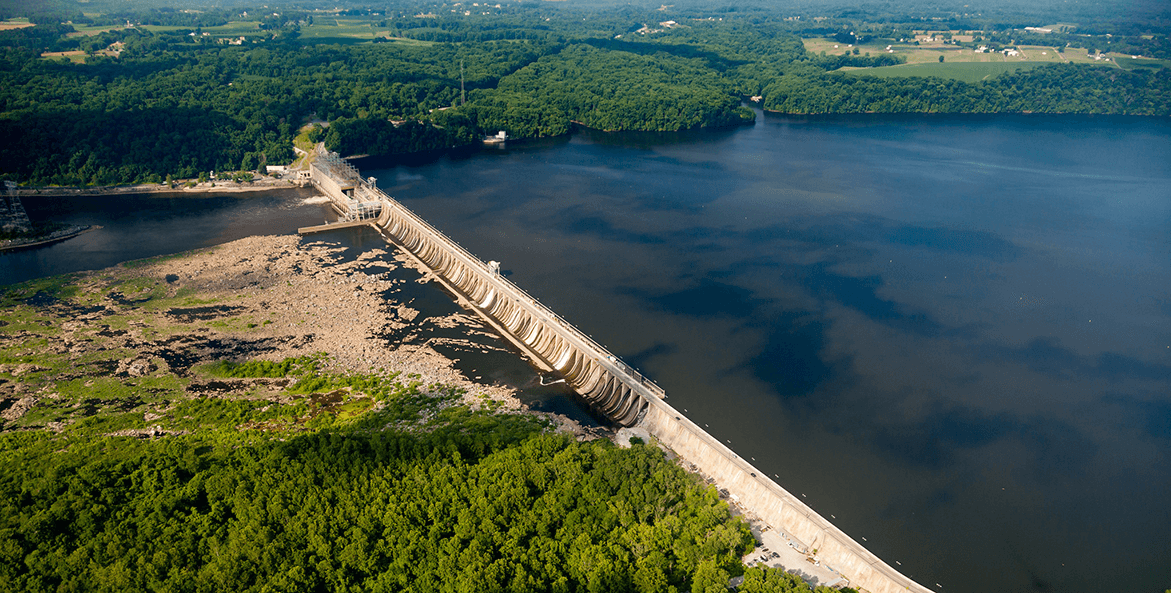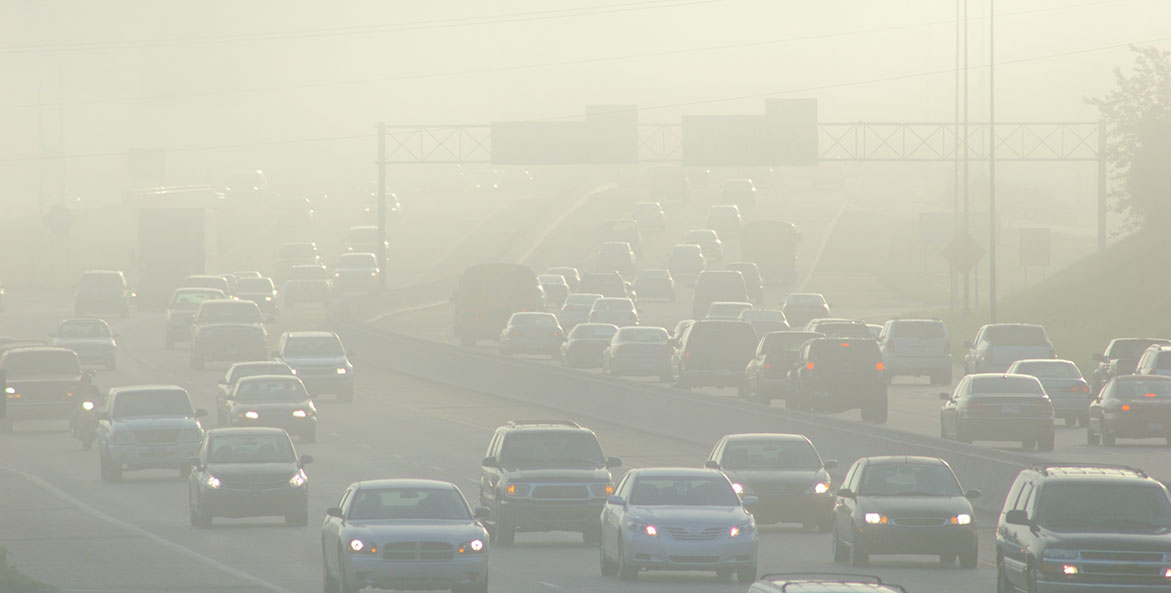The Biden administration has the opportunity to restore environmental protections that were unraveled by the previous administration. These opportunities would help ensure that
- federal water quality standards apply to thousands of acres of wetlands,
- climate change and environmental justice considerations are part of the federal government’s decision-making process, and
- we continue to prioritize the health of our natural resources and humans in the watershed.
These reforms are all necessary to restore the Bay.
WOTUS (Waters of the United States)

Pristine wetlands frame the mouth of the Nansemond River, a tributary of the James River near Suffolk, Virginia. Wetlands play an essential role supporting wildlife and a clean, healthy Chesapeake Bay.
Morgan Heim/iLCP
The Clean Water Act provides federal protections to “navigable waters,” which are defined in the Act as “waters of the United States” (WOTUS). 33 U.S.C. §1362(7). Congress did not define what constitutes WOTUS and left it up to the agencies to interpret the term. This has led to years of debate and numerous court cases attempting to define WOTUS.
In 2015, EPA finalized the Clean Water Rule, defining WOTUS in a way that provided clarity about what types of wetlands require Section 402 and Section 404 Clean Water Act permits, which are essential to Bay restoration. Unfortunately, in 2020, the Trump Administration repealed the 2015 rule and replaced it with a much narrower rule, referred to as the Navigable Waters Protection Rule (NWPR). The NWPR excluded ephemeral features that contain water only during or in response to heavy rains or snow, groundwater, and most roadside or farm ditches. It also left out waters and wetlands that cross state borders from federal protection.
In 2021, a federal court vacated the NWPR. In January 2023, the Biden Administration finalized a new rule reinstating the pre-2015 WOTUS regulations, and updating them to reflect Supreme Court precedent. These safeguards will have positive impacts to the watershed as a whole, and will be particularly important in Delaware and West Virginia which rely on the federal definition of WOTUS to protect wetlands and streams in their jurisdiction.
The Biden Administration also announced it plans to propose a second rule that would make further changes to provide regulatory certainty. The second rule will also give the Biden Administration the opportunity, if needed, to incorporate any new precedent that may come out of the Supreme Court. The administration hopes to release that proposal at the end of 2023 and finalize it in mid-2024.
The National Environmental Policy Act (NEPA)

A sign on State Route 663 in Buckingham County, Virginia, registers opposition to Dominion Energy's Atlantic Coast Pipeline and a proposed compressor station the company plans to site nearby.
Robert Zullo/Virginia Mercury
The National Environmental Policy Act (NEPA) is often referred to as the "Magna Carta" of environmental laws. NEPA ensures the government weighs the environmental consequences of major actions that require federal approval, like the Atlantic Coast Pipeline. By requiring agencies to gather public input and examine less harmful alternatives, NEPA empowers local communities to push back against projects that would impair their air, water, land, and other natural resources and harm their health. This is particularly important for low-income communities and communities of color, which disproportionately suffer the damaging effects of pollution and its health risks but often lack the means and political clout to protect themselves.
In 2020, the Trump Administration finalized a rule that eliminated the requirement that agencies consider all relevant environmental impacts of a federal action, including potential consequences of accelerating climate change and its effects, and further polluting communities already overburdened by pollution. For more, see our press release.
In 2022, the Biden Administration finalized a rule that reversed some of the most damaging changes made by the Trump Administration’s rule, including making NEPA requirements the floor, rather than the ceiling, for environmental standards federal agencies must meet, and requiring agencies to consider all relevant environmental impacts of a federal action. For more, see our press release.
The Biden Administration committed to issuing a rule with broader changes to strengthen NEPA. CBF plans on submitting comments.
State Certification of Proposed Federal Licenses and Permits under the Clean Water Act

The Susquehanna River flows south past Conowingo Dam, toward Havre de Grace, Md., on June 27, 2016. Aerial support by LightHawk.
Will Parson/Chesapeake Bay Program
The Clean Water Act Section 401 provides states and authorized tribes with the authority to grant, deny, or waive certification of proposed federal licenses or permits that may discharge into the waters of the United States, violating the state’s water quality standards. These certifications are challengeable in court. CBF has used this authority to challenge the Atlantic Coast Pipeline and the Conowingo Dam. For additional information, see our Litigation—Active Cases page.
In 2020, the Trump Administration issued a rule that weakened the states’ and tribes’ ability to ensure that their waters are protected by arbitrarily adding new timelines to the process and changing the scope of the certifying authority’s inquiry and bases for setting conditions on and rejecting water quality certifications.
In 2022, the Biden Administration issued a proposed rule that would reinstate the provisions that were in place prior to the Trump Administration rollbacks.
Regulation of Greenhouse Gases from Mobile Sources

Each year, more than 85 million pounds of nitrogen pollution—about one-third of the Bay's total yearly load—comes from air pollution.
iStock
In September of 2019, the National Highway Traffic Safety Administration (NHTSA) and EPA jointly issued a final rule: The Safer Affordable Fuel-Efficient (SAFE) Vehicles Rule Part One: One National Program (SAFE Part One Rule). In this rule, NHTSA and EPA, under separate statutes, removed states’ authority to regulate greenhouse gas emissions from vehicle tailpipes and to implement zero-emission vehicle (ZEV) mandates. CBF filed a comment letter opposing this Rule.
For decades, EPA has granted California a waiver under the Clean Air Act to establish its Clean Cars program, including greenhouse gas emissions and ZEV (zero emissions vehicle) standards. In the Bay watershed, Delaware, Maryland, New York, Pennsylvania, Virginia, and DC have adopted elements of California’s program in order to reduce air pollution and fight climate change. In addition to rescinding California’s authority to establish the Clean Cars program, the Part One Rule also removed other states’ authority to adopt California’s stringent standards.
In response, CBF filed an administrative petition requesting that NHTSA reconsider and withdraw its portion of the Part One Rule. CBF also joined a coalition of public interest groups in filing a petition for review with the D.C. Circuit challenging EPA’s portion of the Part One Rule. Our case was consolidated with other cases filed by NGOs, industry groups, and states.
On January 19, 2021, NHTSA denied CBF’s petition for reconsideration. On January 20, 2021, President Joseph Biden signed Executive Order 13990 on “Protecting Public Health and the Environment and Restoring Science to Tackle the Climate Crisis” which establishes a policy to listen to science and improve public health and protect our environment. The Order directed all executive departments and agencies to review, and as appropriate, take action to address federal regulations finalized during the last four years that conflict with these objectives. On February 8, 2021, the D.C. Circuit granted a motion from the Agencies to hold the consolidated Part One cases in abeyance while the Agencies conduct their review of SAFE Part One.
In April 2021, both Agencies issued proposed rulemakings reconsidering and revising SAFE Part One; CBF joined coalition comments on both regulations. NHTSA issued a final rule repealing its portion of SAFE Part One in December 2021. In March 2022, EPA issued a final rule reinstating California’s waiver and states’ authority to adopt the Clean Cars program.


